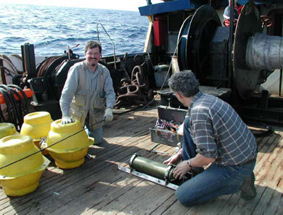



| Making measurements of surface weather conditions in oceanic regions is relatively difficult, and yet these data are needed for many types of climatic and process studies of air-sea interaction. Passive monitoring of the underwater sound field offers a means to make these measurements, as several air-sea interaction processes are responsible for the production and modification of underwater sound in the ocean. In the frequency range from 500 Hertz to 50 kHz, natural sources of underwater sound include breaking wind waves and precipitation. Unique characteristics of these sound sources allow them to be identified and then quantified. Furthermore, distortion of these acoustic signals by sub-surface ambient bubbles permits the detection and quantification of the near-surface bubbles, a potential indication of gas transfer and sea state conditions. |
|
|---|---|
| Using Ambient Sound to Passively Monitor Sea Surface Processes (Keynote Paper: Pan Oceanic Remote Sensing Conference (PORSEC 2002), Bali, Indonesia, September 2002 | |
| Listening to Raindrops: | |
|
An
overview (Nystuen,
1999 - general overview talk from the John D. Nystuen Symposium, The University
of Michigan) |
|
| ARGs on Deep Ocean Moorings : | |
|
Acoustic Log from the South China Sea (Nystuen,
McPhaden and Freitag, 1990) |
|
| The Latest Results: | |
| | Home | | | About | | | Publications | | | Projects | | | Travel Tales | | | Contact | |
|---|
| Copyright 2006 | All Rights Reserved | Site Created by J. Lane |
|---|---|---|
| Last Updated: February 25, 2006 |